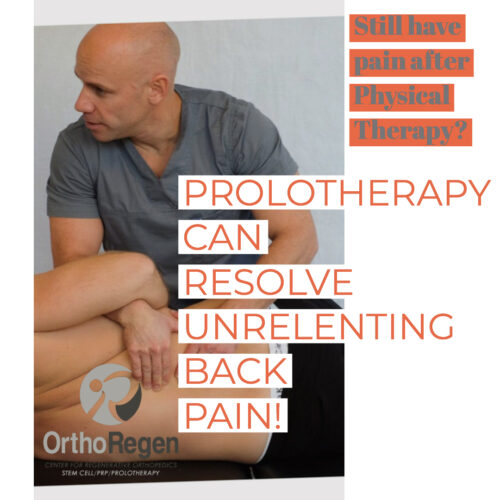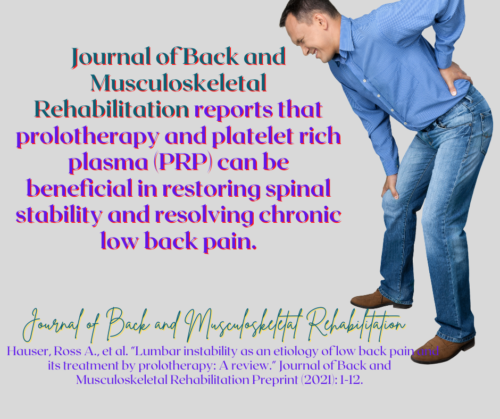
Unrelenting Back Pain Resolved with Prolotherapy
Is your unrelenting back pain becoming progressively worse? And is prolonged sitting or standing for extended periods of time getting more and more difficult? Do you frequently pop or crack your own back to get some relief or are your adjustments not holding? Have you tried all different types of treatments to find some relief?
Does this sound like you? It’s true that many commonly used treatments for back pain can ease some of the pain. For example, sOTC pain medication, NSAIDs, and massage can provide a bit of relief.
When the pain persists, some folks with back pain turn to narcotics, steroids,, and even anti-depressants. But these treatment options come with their own set of problems. Oftentimes, back pain becomes chronic, and can last three to six months or more, with the pain returning again and again.
So why don’t these treatments make the pain go away for good? The pain stays because the underlying causative factor has not been repaired. Pain medications, NSAIDs, steroids, and anti-depressants are not reparative. And they do not fix the ligamentous source of the musculoskeletal pain. They may relieve some of the symptoms for a period of time, but they do not correct the problem. Injured ligaments are frequently the root cause of back pain. Therefore, when they remain unrepaired, the back pain sufferer is left with ongoing pain and will continue to experience difficulties in function and quality of life.
Chiropractors can provide relief for back pain, with care that is often excellent in many cases. However, there are times when back pain becomes more and more frequent, and the adjustments do not hold. In these instances, the patient experiences pain again only a few days after getting treatment. Ligament and/or tendon injuries are very likely at the root of this back pain problem.
Imaging tools, like X-rays and MRI’s, may be helpful in certain situations. But although highly accessible, their usage has not caused the rates of back pain to go down.
Back pain is often the result of an injury, possibly due to sudden movements and poor body mechanics. It may also be due to trauma that transpires during a sports activity, fall,, or motor vehicle accident. Acute injuries, such as minor muscle strains, frequently heal quickly due to the great blood supply and healing capacity of the muscles.
However, many back pain sufferers deal with chronic pain, or pain that lasts more than three to six months. And all too often, the underlying cause is not identified. The common denominator for many painful musculoskeletal conditions causing back pain is spinal instability due to injury to the ligaments. Regenerative Orthopedics is a non-surgical treatment that can provide the solution to heal those injured ligaments and get rid of your back pain.
A herniated disc actually herniates through ligaments. Disc degeneration occurs when ligaments around the spine are injured. That’s why treatment needs to be directed at healing these injured ligaments. Interestingly, when scientists want to induce a disc herniation or degeneration in an animal, they damage the ligaments. After the ligaments are intentionally injured, within a short period of time, the discs will become degenerated or herniated.
Ligaments are supportive structures joining bone to bone. In the back or spine, they connect adjacent vertebrae. The ligaments of the back serve as one of the primary stabilizing structures of the spinal column. They help to provide adequate motion and also restrict excessive movement, which protects the spinal column and nerve roots as they exit the spine.
Instability is part of the pathophysiology of the degenerated and herniated disc. When the ligaments around the spine are injured, excessive joint mobility occurs, and the bones (vertebrae) move too much. The extra movement creates unstable vertebrae, which will result in back pain.
Why does movement lead to pain? The exaggerated motion from instability causes abnormal forces and pressure on the discs between the vertebrae. And that will eventually produce degeneration of the discs. Disc degeneration eventually leads to arthritis. When the ligaments become stretched out or injured, the muscles tighten and generate pain. You feel this in the form of muscle spasms.
If the ligaments and/or muscles are unable to stabilize the vertebrae, the body overgrows bone. This overgrowth of bone produces the loss of motion noted in arthritis as the body tries to stabilize the spine.
Fusion surgery can prevent the motion of these segments that are moving excessively. However, the fusion does not resolve the underlying ligament injury. Back pain may continue even after surgery due to damage in other vertebral regions, like the segments above or below the fusions, or the unaddressed ligament injury.
Regenerative Orthopedic treatments to the area above and below the disc degeneration strengthen the ligaments, resolve the subluxation and instability, and relieve the back pain. The therapy stabilizes the joint by treating the disc degeneration’s underlying cause and relieving back pain.

Prolotherapy and PRP Are Beneficial for Back Pain
Regenerative Orthopedic physicians utilize regenerative injection therapies to stimulate the body to repair the ligaments. Our bodies have exceptional regenerative capabilities. The regenerative medicine approach triggers the body to strengthen the tissue on its own. Regenerative Orthopedics, such as Prolotherapy, Platelet Rich Plasma and Stem Cell Therapy, stimulate the body to heal itself. In the case of unrelenting back pain, regenerative techniques specifically stimulate the repair of the ligaments through which the disc herniates and the ligaments connecting the vertebrae.
One of the wonderful things about Regenerative Orthopedics for back pain is that the individual can maintain activity and get back to sports or other activities they enjoy without extensive downtime. Treatments are individually tailored to promote healing and return people to their active lives. It’s really an amazing transformation to see people regain their mobility and independence!
We strongly recommend looking into Regenerative Orthopedics for those with back pain because it is helpful for many back pain related conditions, including herniated discs, bulging discs, and degenerative disc disease. Why continue to suffer when you can eliminate back pain with Regenerative Orthopedics.
Click here for more articles by Dr. Fields
Hauser, Ross A., et al. “Lumbar instability as an etiology of low back pain and its treatment by prolotherapy: A review.” Journal of Back and Musculoskeletal Rehabilitation Preprint (2021): 1-12.